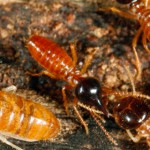Termites
 There are over 300 species of termite in Australia, with the vast majority of termite damage caused by Subterranean (underground) termites.
There are over 300 species of termite in Australia, with the vast majority of termite damage caused by Subterranean (underground) termites.
Termites have been known to feed on many materials including plastics, rubber, fibreglass and of course wood. They attack house frames, wall linings including plaster board, cupboards, skirtings, windows and frames, carpets, plastic coating on electrical wiring and even books, artwork, clothing and personal papers. Termites have a voracious appetite and have a highly organised colony dedicated to a life of seeking a source of food and then consuming that food.
Termites are, in their own way, quite clever in the way they consume this food. They have a strong aversion to sunlight and prefer humid environments and will typically eat wood, for example, from the inside leaving the outside shell to keep them in their preferred darkness in a moist surround. By their foraging underground, this desire for darkness is satiated and it also means they can travel swiftly, silently and undetected to their next source of food.
Subterranean termites are also commonly known in Australia as white ants but in fact termites are not related to the ant at all, they are related to the cockroach family.
Termites play an important role in nature’s environment in that they recycle rotten timber in forests and return valuable nutrients to the soil, but as forests and wooded areas have cleared, termites have found a new food source . . . our homes! Once in our homes we classify them as pests. Termites cause approximately 1 billion dollars of damage to timber each year in Australia and so the importance of having a proven termite detection system for your home, and then a termite treatment if termites are found, is crucial.
Termites are social insects with a colony being made up of a queen and her workers, soldiers and reproductives. The workers termites are the ones that cause all the damage. They are basically blind and sterile. They do all the foraging for food, build the nest and feed all the other members of the colony.
When termites want or need to venture out of the timber or travel across a surface to reach timber they construct mud like tunnels which are made from faeces and saliva. These mud-like tunnels also serve the purpose of protecting from predators. Soldier termites also play their part in protecting worker termites from predators.
The queen can live up to 50 years in ideal conditions and can lay up to 30,000 eggs per day which can equate to 165 million eggs in her lifetime! Here’s a very informative video from National Geographic about the termite queen:
Termites can and will travel long distances from the colony to find food. They may forage 50-100 metres from the nest. They will find numerous ways into a building, be it from under the floor, cracks in concrete, plumbing, penetrating up the cavity wall etc.
As a homeowner there are many things we can do as part of an integrated management approach to reduce the risk of termite attack. These include removing all loose timbers, fixing leaking taps and adequate ventilation to sub floors.



 Purchase a TermiWatch system you will be able to directly contact the TermiWatch Inventor and Manufacturer for professional technical support.
Purchase a TermiWatch system you will be able to directly contact the TermiWatch Inventor and Manufacturer for professional technical support.
